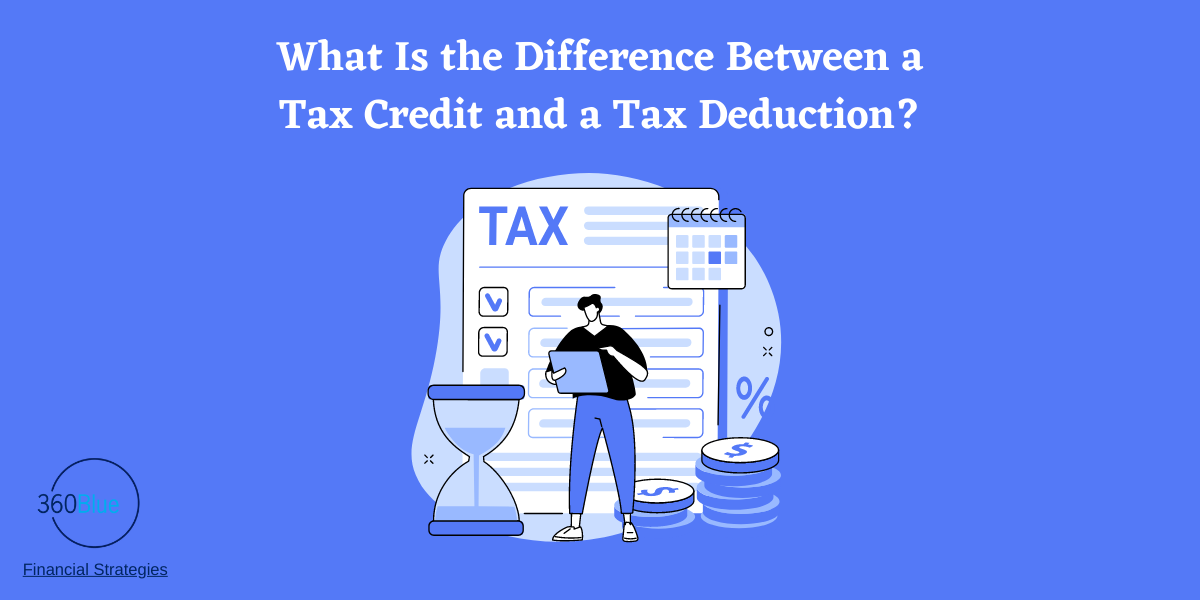What is the Difference Between a Tax Credit and a Tax Deduction?
Submitted by 360Blue Financial Strategies on March 25th, 2022
When it comes to preparing your taxes, the idea of tax credits and tax deductions can be music to any taxpayer’s ears. That’s because both are used to lower the amount of taxes someone owes to the government. While they’re both worth getting excited over, it’s important to understand the fundamental difference between these two terms.
What Are Tax Credits?
Simply put, tax credits are reductions on the amount of actual tax owed. Tax credits in no way affect your tax bracket or taxable income. Instead, think of these as reductions that come after the fact - i.e. after you’ve determined how much you owe to the government. There are a few common types of tax credits that can be given based on your income level, whether or not you have children, if you’re a college student and more. These common credits include:
-
Child Tax Credit
-
Child and Dependent Care Credit
-
Lifetime Learning Credit
-
Adoption Credit
-
Earned Income Tax Credit
-
Residential Energy Tax Credit
Tax credits are typically either refundable or non-refundable. Depending on which type of credit it is, this will affect how much you’ll receive back on your tax refund.
Refundable Tax Credits
Refundable tax credits are tax credits that allow you to be refunded the remaining, unused portion of a credit. For example, say you owe $900 in taxes, but your eligible child tax credit is worth $2,000. Not only will this cover the $900 you owe in taxes, but you will also be refunded the remaining $1,100.
Non-Refundable Tax Credits
Alternatively, non-refundable tax credits will only cover the taxes you owe, up to the credit’s limit. If there is more in the credit amount than what you owe, you do not receive the excess amount in the form of a tax refund. For example, if you owe $900 in taxes and your tax credit is worth up to $2,000, the $900 will be covered but you will not receive the additional $1,100.
What Are Tax Deductions?
Tax deductions are used to reduce the amount of income that’s eligible to be taxed. By reducing this amount, your income may fall into a lesser tax bracket, meaning you’re subject to pay a lesser tax percentage. There are typically two types of tax deductions: itemized deductions and above-the-line deductions.
Itemized Deductions
You can use itemized deductions to help lower your taxable income. Common types of itemized deductions include:
-
Charitable donations
-
Medical expenses
-
Property taxes
-
Mortgage interest
While people are welcome to add each deduction up separately on their taxes (i.e. itemize them), most will opt for the standard deduction set by the IRS. For the 2022 income tax year, these are the standard deduction amounts:
-
Single or married but filing separately: $12,950
-
Married and filing jointly or qualifying widow(er): $25,900
-
Head of household: $19,4001
It is common to use a standard deduction because, in most cases, an itemized amount won’t exceed the IRS’s standard deduction rates.
Above-The-Line Deductions
Above-the-line deductions are used to reduce your adjusted gross income (AGI), which can qualify you for certain itemized deductions and tax credits. Your adjusted gross income is determined by subtracting above-the-line deductions from your gross income. This lower AGI can then allow you to claim important tax credits or deductions that may be dependent on income level. Common above-the-line deductions include:
-
Alimony paid
-
Educator expenses
-
Student loan interest
-
Deductible IRA contributions
-
Moving expenses of armed forces members
Tax credits and tax deductions can both greatly benefit taxpayers, especially when they work in tandem. Familiarizing yourself with the difference between these two tax terms gives you a great place to start researching and understanding what deductions and credits you and your spouse may be eligible for in the upcoming tax year.
This is for educational purposes only. United Planners and its representatives do not offer tax advice.

